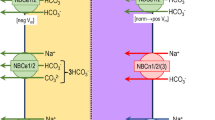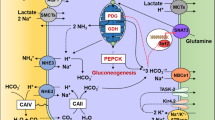Abstract
Direct effects on epithelial Na+ channels (ENaC) activity by lipids, e.g., arachidonic acid (AA), eicosatetraynoic acid (ETYA), linoleic acid (LA), stearic acid (SA), hydroxyeicosatetraenoic acid (HETE), 11,12–epoxyeicosatrienoic acid (EET), (PGF2), and (PGE2), in cultured mouse cortical collecting duct (M1) cells were clarified by using single-channel recordings in this study. In a cell-attached recording, a bath application of 10 μM AA significantly reduced the ENaC open probability (NPo), whereas 10 μM ETYA or 5 μM LA only induced a slight inhibition. The inside-out recording as a standard protocol was thereafter performed to examine effects of these lipids on ENaC activity. Within 10 min after the formation of the inside-out configuration, the NPo of ENaC in cultured mouse cortical collecting duct (M1) cells remained relatively constant. Application of ETYA or LA or SA exhibited a similar inhibition on the channel NPo when applied to the extracellular side, suggesting that fatty acids could exert a nonspecific inhibition on ENaC activity. 11,12-EET, a metabolite of AA via the cytochrome P450 epoxygenase pathway, significantly inhibited the ENaC NPo, whereas 20-HETE, a metabolite of AA via the hydroxylase pathway, only caused a small inhibition of the ENaC NPo, to a similar degree as that seen with ETYA and LA. However, both PGE2 and PGF2α significantly enhanced the ENaC NPo. These results suggest that fatty acids exert a nonspecific effect on ENaC activity due to the interaction between the channel proximity and the lipid. The opposite effects of 11,12-EET and prostaglandin (PG) implicate different mechanisms in regulation of ENaC activity by activation of epoxygenase and cyclooxygenase.






Similar content being viewed by others
References
Anantharam A, Tian Y, Palmer LG (2006) Open probability of the epithelial sodium channel is regulated by intracellular sodium. J Physiol 574:333–347
Bonvalet JP, Pradelles P, Farman N (1987) Segmental synthesis and actions of prostaglandins along the nephron. Am J Physiol 253:F377–F387
Breyer MD, Breyer RM (2000) Prostaglandin receptors: their role in regulating renal function. Curr Opin Nephrol Hypertens 9:23–29
Breyer MD, Breyer RM (2001) G protein-coupled prostanoid receptors and the kidney. Annu Rev Physiol 63:579–605
Breyer MD, Harris RC (2001) Cyclooxygenase 2 and the kidney. Curr Opin Nephrol Hypertens 10:89–98
Breyer MD, Jacobson HR, Breyer RM (1996) Functional and molecular aspects of renal prostaglandin receptors. J Am Soc Nephrol 7:8–17
Breyer MD, Zhang Y, Guan YF, Hao CM, Hebert RL, Breyer RM (1998) Regulation of renal function by prostaglandin E receptors. Kidney Int Suppl 67:S88–S94
Breyer RM, Kennedy CR, Zhang Y, Breyer MD (2000) Structure-function analyses of eicosanoid receptors. Physiologic and therapeutic implications. Ann N Y Acad Sci 905:221–231
Breyer RM, Kennedy CR, Zhang Y, Guan Y, Breyer MD (2002) Targeted gene disruption of the prostaglandin E2 EP2 receptor. Adv Exp Med Biol 507:321–326
Carattino MD, Hill WG, Kleyman TR (2003) Arachidonic acid regulates surface expression of epithelial sodium channels. J Biol Chem 278:36202–36213
Chen SY, Bhargava A, Mastroberardino L, Meijer OC, Wang J, Buse P, Firestone GL, Verrey F, Pearce D (1999) Epithelial sodium channel regulated by aldosterone-induced protein sgk. Proc Natl Acad Sci USA 96:2514–2519
Chyb S, Raghu P, Hardie RC (1999) Polyunsaturated fatty acids activate the Drosophila light-sensitive channels TRP and TRPL. Nature 397:255–259
Denson DD, Wang X, Worrell RT, Eaton DC (2000) Effects of fatty acids on BK channels in GH(3) cells. Am J Physiol Cell Physiol 279:C1211–C1219
Eaton DC, Malik B, Saxena NC, Al-Khalili OK, Yue G (2001) Mechanisms of aldosterone’s action on epithelial Na+ transport. J Membr Biol 184:313–319
Els WJ, Helman SI (1997) Dual role of prostaglandins (PGE2) in regulation of channel density and open probability of epithelial Na+ channels in frog skin (R. pipiens). J Membr Biol 155:75–87
Farman N, Pradelles P, Bonvalet JP (1986) Determination of prostaglandin E2 synthesis along rabbit nephron by enzyme immunoassay. Am J Physiol 251:F238–F244
Friedrich B, Feng Y, Cohen P, Risler T, Vandewalle A, Broer S, Wang J, Pearce D, Lang F (2003) The serine/threonine kinases SGK2 and SGK3 are potent stimulators of the epithelial Na+ channel alpha, beta, gamma-ENaC. Pflugers Arch 445:693–696
Goodman DB, Wong M, Rasmussen H (1975) Aldosterone-induced membrane phospholipid fatty acid metabolism in the toad urinary bladder. Biochemistry 14:2803–2809
Gorelik J, Gu Y, Spohr HA, Shevchuk AI, Lab MJ, Harding SE, Edwards CR, Whitaker M, Moss GW, Benton DC, Sanchez D, Darszon A, Vodyanoy I, Klenerman D, Korchev YE (2002) Ion channels in small cells and subcellular structures can be studied with a smart patch-clamp system. Biophys J 83:3296–3303
Guan Y, Zhang Y, Breyer RM, Fowler B, Davis L, Hebert RL, Breyer MD (1998) Prostaglandin E2 inhibits renal collecting duct Na+ absorption by activating the EP1 receptor. J Clin Invest 102:194–201
Hebert RL, Breyer RM, Jacobson HR, Breyer MD (1995) Functional and molecular aspects of prostaglandin E receptors in the cortical collecting duct. Can J Physiol Pharmacol 73:172–179
Hebert RL, Carmosino M, Saito O, Yang G, Jackson CA, Qi Z, Breyer RM, Natarajan C, Hata AN, Zhang Y, Guan Y, Breyer MD (2005) Characterization of a rabbit kidney prostaglandin F(2{alpha}) receptor exhibiting G(i)-restricted signaling that inhibits water absorption in the collecting duct. J Biol Chem 280:35028–35037
Hill WG, An B, Johnson JP (2002) Endogenously expressed epithelial sodium channel is present in lipid rafts in A6 cells. J Biol Chem 277:33541–33544
Hornych A, Bedrossian J, Bariety J, Menard J, Corvol P, Safar M, Fontaliran F, Milliez P (1975) Prostaglandins and hypertension in chronic renal diseases. Clin Nephrol 4:144–151
Kim D, Clapham DE (1989) Potassium channels in cardiac cells activated by arachidonic acid and phospholipids. Science 244:1174–1176
Kokko KE, Matsumoto PS, Ling BN, Eaton DC (1994) Effects of prostaglandin E2 on amiloride-blockable Na+ channels in a distal nephron cell line (A6). Am J Physiol 267:C1414–C1425
Lazzeri M, Barbanti G, Beneforti P, Maggi CA, Taddei I, Andrea U, Cantini C, Castellani S, Turini D (1995) Vesical–renal reflex: diuresis and natriuresis activated by intravesical capsaicin. Scand J Urol Nephrol 29:39–43
Ma HP, Saxena S, Warnock DG (2002) Anionic phospholipids regulate native and expressed epithelial sodium channel (ENaC). J Biol Chem 277:7641–7644
Makita K, Takahashi K, Karara A, Jacobson HR, Falck JR, Capdevila JH (1994) Experimental and/or genetically controlled alterations of the renal microsomal cytochrome P450 epoxygenase induce hypertension in rats fed a high salt diet. J Clin Invest 94:2414–2420
Matsumoto PS, Mo L, Wills NK (1997) Osmotic regulation of Na+ transport across A6 epithelium: interactions with prostaglandin E2 and cyclic AMP. J Membr Biol 160:27–38
Michaelis UR, Fisslthaler B, Barbosa-Sicard E, Falck JR, Fleming I, Busse R (2005) Cytochrome P450 epoxygenases 2C8 and 2C9 are implicated in hypoxia-induced endothelial cell migration and angiogenesis. J Cell Sci 118:5489–5498
Narumiya S (1994) Prostanoid receptors. Structure, function, and distribution. Ann N Y Acad Sci 744:126–138
Nielsen R (1990) Prostaglandin E2 enhances the sodium conductance of exocrine glands in isolated frog skin (Rana esculenta). J Membr Biol 113:31–38
Nusing RM, Seyberth HW (2004) The role of cyclooxygenases and prostanoid receptorsin furosemide-like salt losing tubulopathy: the hyperprostaglandin E syndrome. Acta Physiol Scand 181:523–528
Oliver D, Lien CC, Soom M, Baukrowitz T, Jonas P, Fakler B (2004) Functional conversion between A-type and delayed rectifier K+ channels by membrane lipids. Science 304:265–270
Ordway RW, Walsh JV Jr, Singer JJ (1989) Arachidonic acid and other fatty acids directly activate potassium channels in smooth muscle cells. Science 244:1176–1179
Smith WL (1992) Prostanoid biosynthesis and mechanisms of action. Am J Physiol 263:F181–F191
Smith WL, Marnett LJ, DeWitt DL (1991) Prostaglandin and thromboxane biosynthesis. Pharmacol Ther 49:153–179
Staruschenko A, Nichols A, Medina JL, Camacho P, Zheleznova NN, Stockand JD (2004a) Rho small GTPases activate the epithelial Na(+) channel. J Biol Chem 279:49989–49994
Staruschenko A, Patel P, Tong Q, Medina JL, Stockand JD (2004b) Ras activates the epithelial Na(+) channel through phosphoinositide 3-OH kinase signaling. J Biol Chem 279:37771–37778
Sugimoto Y (2006) Expression and function of prostanoid receptors. Seikagaku 78:1039–1049
Sugimoto Y, Narumiya S (2007) Prostaglandin E receptors. J Biol Chem 282:11613–11617
Sun P, Lin DH, Wang T, Babilonia E, Wang Z, Jin Y, Kemp R, Nasjletti A, Wang WH (2006) Low Na intake suppresses expression of CYP2C23 and arachidonic acid–induced inhibition of ENaC. Am J Physiol Renal Physiol 291:F1192–F1200
Vallet V, Chraibi A, Gaeggeler HP, Horisberger JD, Rossier BC (1997) An epithelial serine protease activates the amiloride-sensitive sodium channel. Nature 389:607–610
Wegmann M, Nusing RM (2003) Prostaglandin E2 stimulates sodium reabsorption in MDCK C7 cells, a renal collecting duct principal cell model. Prostaglandins Leukot Essent Fatty Acids 69:315–322
Wei Y, Lin DH, Kemp R, Yaddanapudi GS, Nasjletti A, Falck JR, Wang WH (2004) Arachidonic acid inhibits epithelial Na channel via cytochrome P450 (CYP) epoxygenase-dependent metabolic pathways. J Gen Physiol 124:719–727
Wei Y, Sun P, Wang Z, Yang B, Carroll MA, Wang WH (2006) Adenosine inhibits ENaC via cytochrome P-450 epoxygenase-dependent metabolites of arachidonic acid. Am J Physiol Renal Physiol 290:F1163–F1168
Worrell RT, Bao HF, Denson DD, Eaton DC (2001) Contrasting effects of cPLA2 on epithelial Na+ transport. Am J Physiol Cell Physiol 281:C147–C156
Wu KK, Liou JY (2005) Cellular and molecular biology of prostacyclin synthase. Biochem Biophys Res Commun 338:45–52
Yorio T, Bentley PJ (1978) Phospholipase A and the mechanism of action of aldosterone. Nature 271:79–81
Yue G, Malik B, Yue G, Eaton DC (2002) Phosphatidylinositol 4,5-bisphosphate (PIP2) stimulates epithelial sodium channel activity in A6 cells. J Biol Chem 277:11965-11969
Acknowledgment
This study was partly supported by BBSRC (BB/D524032).
Author information
Authors and Affiliations
Corresponding author
Rights and permissions
About this article
Cite this article
Wang, S., Meng, F., Xu, J. et al. Effects of Lipids on ENaC Activity in Cultured Mouse Cortical Collecting Duct Cells. J Membrane Biol 227, 77–85 (2009). https://doi.org/10.1007/s00232-008-9145-1
Received:
Accepted:
Published:
Issue Date:
DOI: https://doi.org/10.1007/s00232-008-9145-1




